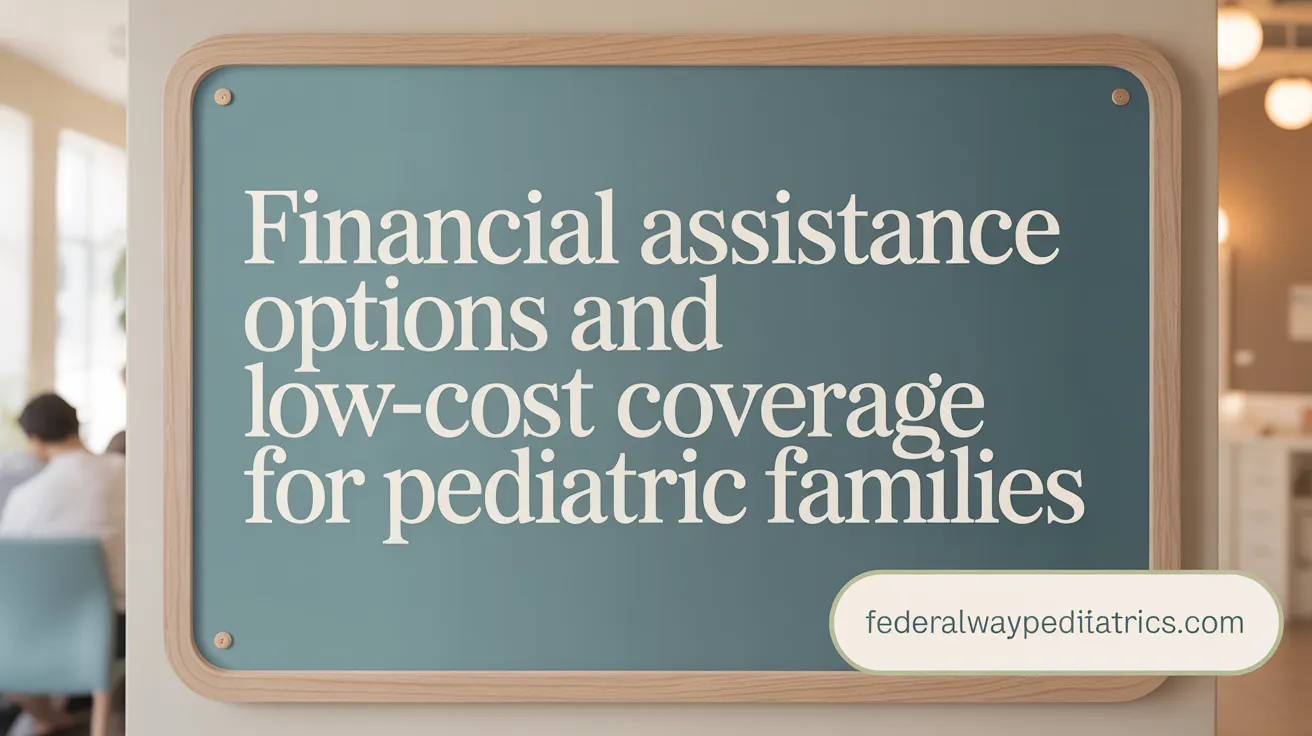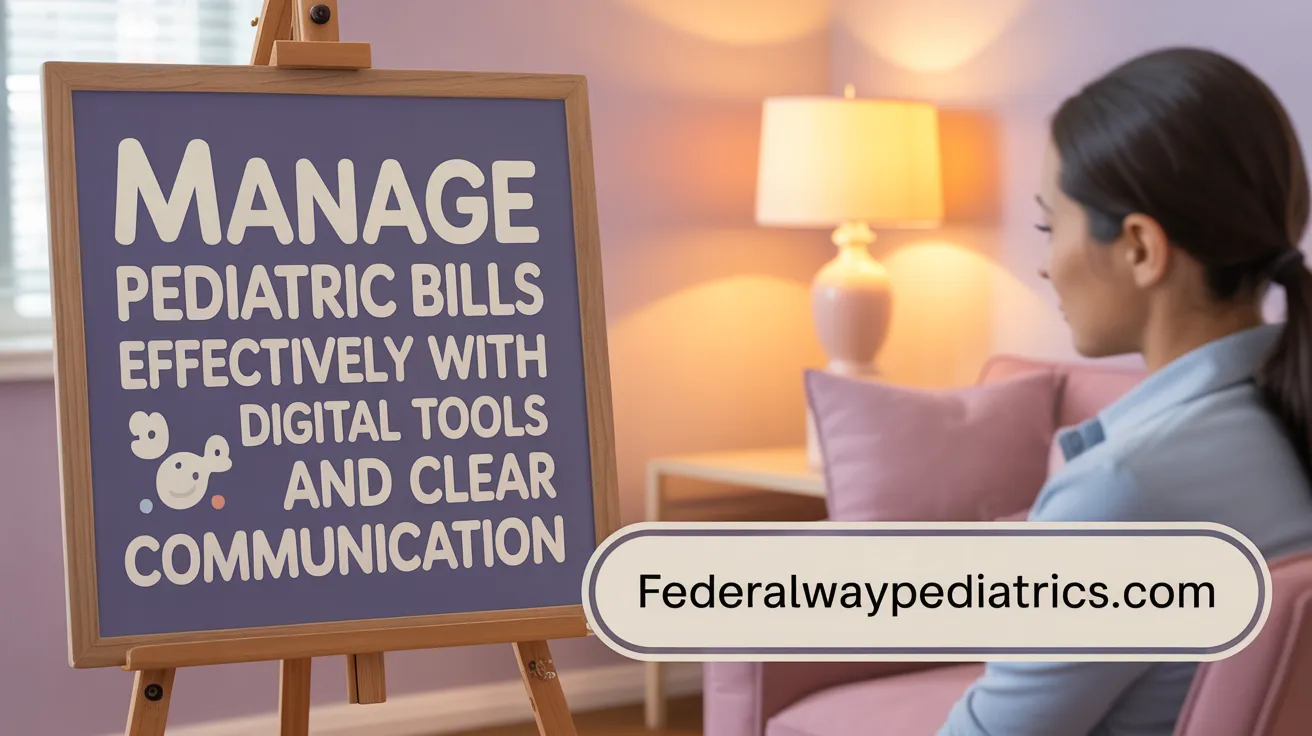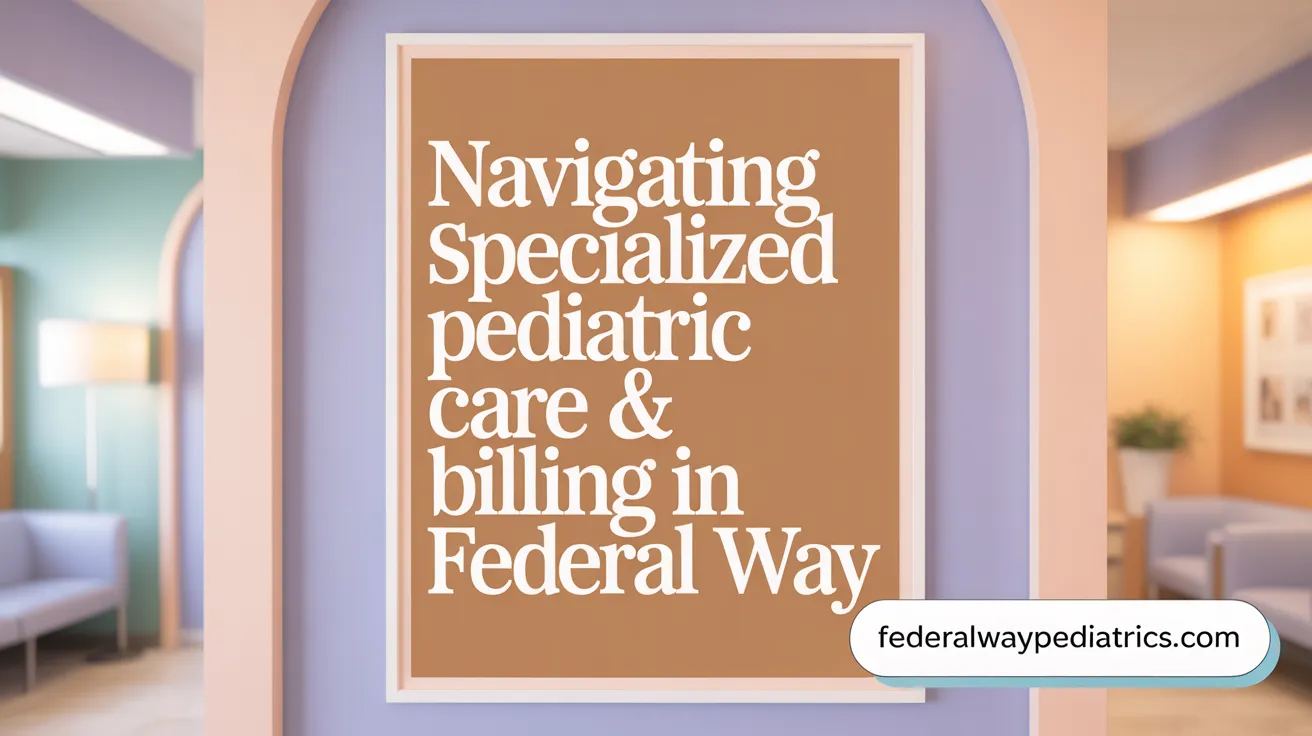Why Understanding Pediatric Healthcare Payment Options Matters
Overview of pediatric healthcare payment landscape
Pediatric healthcare payment involves a complex process where services are coded and billed using diagnostic (ICD) and procedural (CPT) codes. Insurance plans—ranging from employer-based health benefits to government programs like Medicaid (Apple Health in Washington)—cover many services but vary widely in coverage. Providers often accept a variety of plans, including commercial, exchange, Medicare, and Medicaid options, with specific practices in Federal Way, Washington, navigating these options to meet local family needs.
Importance of grasping payment methods and insurance coverage
Understanding how pediatricians bill for services, including routine screenings and vaccinations, helps families prepare for potential charges. Copayments typically are due at the time of the visit, with options to pay via credit card or check. Insurance plans differ in covered services and may require families to verify network status and benefits to avoid surprises. Tools such as patient portals facilitate management of appointments and bills, while healthcare providers offer transparent cost estimates and financial counseling.
Impact on families anticipating out-of-pocket costs
Families benefit greatly from knowing their insurance coverage details to anticipate out-of-pocket expenses like copays, deductibles, or coinsurance, especially when additional procedures or labs are needed. Program eligibility, such as for Apple Health for Kids, can reduce costs significantly for low- to moderate-income households. Clear communication with pediatric offices and insurers is vital as billing practices and insurance benefits may change yearly, influencing what families owe and enhancing their ability to make informed healthcare decisions.
Decoding Pediatric Billing: How Pediatricians Are Paid

How are pediatric services coded and billed?
Pediatric billing relies on diagnostic codes known as Explanation of Benefits (EOB) and CPT codes to detail the services provided to children. For example, Pediatrician payment process: Common pediatric CPT codes including well baby checkup code 99381 and MMR vaccine code 90707 form the basis of the claims submitted to insurance payers.
Common procedural codes for pediatric services
Some frequently used Common pediatric CPT codes include:
- 99381: Well baby checkup code 99381
- 12001: Laceration repair code 12001
- 76856: Ultrasound CPT code 76856
- 99213: Office visit code 99213
- 36415: Blood draw CPT code 36415
- 90707: MMR vaccine code 90707
Each code specifies exactly what service was provided, helping insurance companies process payments accurately.
Complexities of coding and billing processes
Pediatric billing is complex due to ongoing Annual changes in insurance payment and coding practices, multiple codes required for a single service, and differences in insurance plans. Some services may be billed Globally vs à la carte coding, covering all care for a period, while others are itemized individually, known as à la carte billing. This complexity means families must engage in Communication with pediatric offices and insurers to fully understand charges, including out-of-pocket expenses.
Role of vaccine coding and administration fees
Vaccine billing includes separate Vaccine coding and administration codes for the vaccine itself and for delivering the vaccine. These codes vary according to vaccine type and method of administration. Despite billing complexities, pediatric practices often provide vaccines considering the Financial impact of vaccines in pediatrics, underscoring their public health importance.
Importance of communication with pediatric offices about billing
Clear communication between families and pediatric offices is essential. Understanding how services are coded helps anticipate Insurance coverage review and potential Understanding out-of-pocket expenses. Insurance companies assess claims based on submitted codes and benefits, which may affect approvals or denials. Families are encouraged to discuss Billing questions with their pediatric provider and verify coverage details with insurers regularly.
Insurance Coverage and Payment Structures for Pediatric Care

What types of insurance plans do pediatric practices accept?
Pediatric practices in Federal Way commonly accept a broad spectrum of insurance plans. These include commercial insurance, exchange plans, government-sponsored coverage, Medicaid (locally known as Apple Health for Kids eligibility), and Medicare Advantage plans. Prominent providers in the area include Premera Blue Cross Insurance, Regence BlueShield Coverage, and Kaiser Foundation Health Plan of Washington. Many clinics and hospitals participate in multiple plans to accommodate diverse family needs.
How do copayments and deductibles affect families?
Families typically must pay copayments at the time of the child's visit. Additionally, depending on their insurance plan, they may receive bills for deductibles or coinsurance for services partially covered by insurance. For example, routine screenings or lab tests may incur extra charges. These payments directly impact the out-of-pocket expenses families face and vary according to the specifics of each insurance policy, as detailed under PHCA accepted health plans.
Why must families verify insurance details before appointments?
Insurance coverage differs significantly between plans, especially regarding in-network providers and covered services. Verifying insurance details ensures that needed pediatric care, lab work, or specialty visits will be covered. Without this verification, families risk unexpected bills, particularly if services are rendered out of network or for procedures not covered by their plan. Resources on the importance of insurance verification for out-of-network plans highlight these considerations.
Role of employer-based, government, Medicaid/Apple Health coverage
Many families obtain healthcare coverage through employer-sponsored insurance plans or public programs like Medicaid/Apple Health for Kids eligibility. Apple Health offers free or low-cost coverage based on income, providing continuous eligibility for young children and premium-based options for older children. This government program is essential in supporting health access among lower-income families in Federal Way.
Influence of insurance changes on payment responsibility
Insurance policies and benefits often evolve annually, affecting coverage and patient financial responsibility. Pediatric practices advise families to stay informed about changes and maintain communication with insurance providers and healthcare offices to anticipate potential cost variations and ensure smooth payment processes. Information about annual changes in insurance payment can help families plan accordingly.
Financial Assistance and Low-Cost Coverage Options for Families

What public programs support pediatric healthcare costs?
Washington State’s Apple Health for Kids eligibility program provides vital support to families by offering free or low-cost healthcare coverage for children who meet income requirements. Eligibility is based on household income with specific monthly thresholds—for example, a single-person household must earn $2,804 or less to qualify for free coverage. Children younger than six benefit from continuous eligibility, ensuring their coverage remains intact through the month they turn six, even if income changes. Older children on Apple Health also receive extended coverage, typically lasting 12 months once enrolled.
What financial assistance options exist beyond Medicaid?
Beyond Medicaid, pediatric hospitals such as Seattle Children’s financial assistance program offer additional financial assistance programs. These programs provide partial aid to families whose incomes exceed Medicaid thresholds but may still struggle with medical costs. Assistance levels are income-based, with discounts lowering patient financial responsibility—patients never pay more than 48% of standard billed amounts. However, financial aid generally excludes elective or cosmetic procedures. Families can get help applying for Medicaid or other insurance plans through hospital support services designed to ease access to necessary care.
Understanding exclusions and applying for assistance
Families should note that elective services like cosmetic procedures or elective education are typically excluded from financial assistance programs. The application process for Apple Health requires documentation of household income, Social Security numbers, birthdates, and immigration status if applicable. Coverage begins on the first day of the application month, and families receive a ProviderOne services card shortly after acceptance through the Apple Health for Kids coverage process.
These programs and financial assistance options are designed to help families in Federal Way, Washington, confidently manage pediatric healthcare expenses while ensuring children receive the care they need regardless of financial status.
Managing Billing and Payments: Tools and Best Practices for Families

How can families manage pediatric healthcare bills effectively?
Families seeking to streamline pediatric healthcare billing can benefit greatly from digital tools such as the MyChart Portal for payment. This secure platform allows patients and caregivers to view outstanding balances, make payments, and even obtain cost estimates before the appointment. Using MyChart helps families stay ahead of their financial responsibilities and plan accordingly.
Understanding Explanation of Benefits (EOB) statements is also essential. These documents break down how insurance processed a claim, detailing what the insurer paid and what portion remains the patient's responsibility. Being familiar with EOB statements enables families to catch any discrepancies early and communicate effectively with their pediatrician's billing department.
Maintaining open communication lines with billing offices is crucial. Promptly addressing questions or concerns and verifying coverage details can prevent unexpected bills. Pediatric practices are generally willing to assist in clarifying charges or setting up payment arrangements, emphasizing partnership in managing healthcare finances. For more on communication with pediatric offices and insurance coverage review, see the resources provided.
What costs might families encounter beyond office visits?
Beyond routine office visits, families should anticipate charges from a range of additional services. Common examples include routine screenings such as hearing and vision tests, anemia and lead poisoning screenings, and developmental assessments. These screenings are vital for comprehensive pediatric care but may incur extra fees depending on insurance coverage as detailed under routine screening tests at PHCA.
Vaccinations often involve two separate billing components: the vaccine itself and the administration procedure. Notably, many pediatricians provide vaccine coding and administration at little or no profit, underscoring their commitment to public health. Additional services like blood draw CPT code 36415, laboratory tests, and urgent care visits can also contribute to overall expenses.
Due to the complexity of insurance benefits and annual changes in insurance payment, families are encouraged to verify insurance verification for out-of-network plans and coverage specifics beforehand. This proactive step can help anticipate any out-of-pocket costs and avoid surprises at the time of service.
No Surprise Act and Payment Transparency
In compliance with the No Surprise Act billing estimates, healthcare providers now offer clear estimates of charges upfront. Families are encouraged to request these estimates and discuss expected payments during the visit, ensuring informed financial decision-making and enhanced transparency. For additional information on price transparency at Children's Health and financial counseling for billing support, please consult the linked resources.
Specialized Pediatric Care and Payment Considerations in Federal Way

How is specialized pediatric care accessed and billed?
Families in Federal Way, Washington, seeking specialized pediatric care, such as pediatric cardiology care in Federal Way, typically need a referral from their primary care provider. This referral process ensures coordination of care and timely appointment scheduling at local centers like Mary Bridge Children’s Hospital outpatient center and the South Sound Cardiology clinics. These centers provide comprehensive services including diagnosis, treatment, and tailored care plans for congenital and acquired heart conditions.
Specialty services are often billed separately from primary care visits and may involve different insurance coverage. Many specialty clinics accept a broad range of insurance plans, including Medicaid (Apple Health for Kids eligibility, commercial plans, and exchange coverage, but families should verify network participation to avoid unexpected costs.
What should families know about specialty billing?
Billing for specialty pediatric care can be more complex than for routine visits. Accredited facilities, such as those certified by the Accreditation Association for Ambulatory Health Care, uphold standardized billing and quality assurance protocols, helping to ensure transparency and reliability.
Families should be proactive in discussing billing details with their specialty care providers and insurance companies. Payment responsibilities may include copayments, deductibles, or coinsurance, which can vary by insurance plan and service rendered. Many outpatient centers use patient portals like MyChart Portal for payment to facilitate billing inquiries, payments, and access to Explanation of Benefits (EOB) statements.
Clear communication and understanding of insurance benefits help families anticipate and manage out-of-pocket expenses effectively, promoting a smoother experience during their child’s specialty care journey.
Empowering Families Through Payment Awareness in Pediatric Healthcare
Understanding payment options is essential for families to provide the best care for their children while managing healthcare costs.
Families can benefit greatly from knowing about various insurance plans accepted by pediatric providers in Federal Way, Washington, including Medicaid (Apple Health for Kids), private insurance, and state exchange plans. Programs like Apple Health for Kids offer free or low-cost coverage based on household income, ensuring access to crucial pediatric services.
Utilizing available tools and support services empowers parents.
Many clinics and hospitals provide resources such as online portals (e.g., MyChart) for managing bills, cost estimator tools for anticipating expenses, and financial counselors to explain charges and payment assistance. These resources help families plan and prepare for out-of-pocket costs.
Effective communication with healthcare providers and insurers is vital.
Since insurance benefits and billing procedures can change annually and differ across plans, families should verify coverage details before visits and discuss any billing questions promptly with their pediatrician's office. Understanding diagnostic and procedural codes further aids in clarifying billing statements.
Building confidence in navigating pediatric healthcare costs supports family-centered care.
Being informed about insurance options, billing practices, and financial assistance programs enables families to advocate effectively for their children's health needs with assurance and clarity. This proactive approach fosters a supportive and transparent environment for pediatric healthcare decisions.
